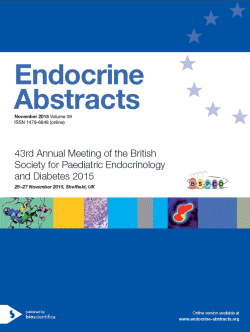Searchable abstracts of presentations at key conferences in endocrinology

Society for Endocrinology BES 2015
Edinburgh,
UK
02 Nov 2015 - 04 Nov 2015

2-4 November 2015, Edinburgh, UK
Further information
Symposia
Blood and guts: how the intestine transduces nutritional cues to endocrine signals (Supported by <emphasis role="italic">Journal of Endocrinology</emphasis>)
ea0038s10.2 | Blood and guts: how the intestine transduces nutritional cues to endocrine signals (Supported by <emphasis role="italic">Journal of Endocrinology</emphasis>) | SFEBES2015
The glucoregulatory role of small intestinal nutrient- and pharmacological-sensing
The gastrointestinal tract is anatomically positioned to play a crucial role in the regulation of metabolic homeostasis, providing critical postingestive negative feedback to regulate both exogenous energy intake, as well as endogenous glucose production. This talk will highlight the ability of small intestinal lipid sensing to lower glucose production via a gutbrainliver axis that is dependent on local gut peptide signaling. Furthermore, recent evidence indicates ...
ea0038s10.3 | Blood and guts: how the intestine transduces nutritional cues to endocrine signals (Supported by <emphasis role="italic">Journal of Endocrinology</emphasis>) | SFEBES2015
Short chain fatty acids in the regulation of energy homeostasis
In recent years, there has been a renewed interest in the role of dietary fibre in obesity management. Much of this interest stems from animal and human studies that suggest increased intake of fermentable fibre can improve body composition.A growing number of reports have demonstrated that the principal products of colonic fermentation of dietary fibre, short chain fatty acids (SCFAs), contribute to energy homeostasis via effects on cellular metabolic p...



